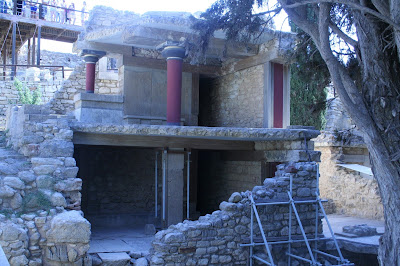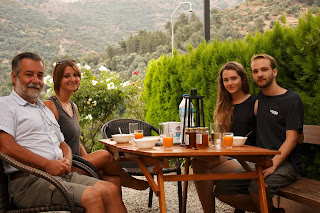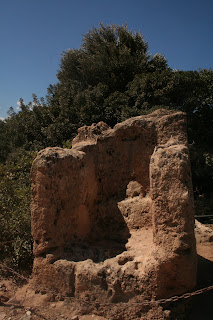It was a fairly brief ferry ride, and as we pulled into the harbour of Halki, I was filled with absolute wonder; it was like something out a fairytale, and not somewhere you expect to actually end up.
As soon as the ferry docked, the tourists spilled out and milled around in a large group, before heading off in one direction like sheep, all staying together. Keen to escape, we headed in the opposite direction like the rebels we are! We soon found ourselves climbing up through the village, giving us beautiful views back on the harbour, and bringing us past the clock tower that dominated the skyline. Interestingly enough, when the sponge trade (which was an important and lucrative trade in the islands around for a long time) began to fail, many sponge divers moved to Florida to continue their profession there, however they never forgot their roots on Halki and it is the expats in Florida that paid for the clocktower here in their motherland.
After some wandering, we found it to be much quieter a little way away from the harbour. We decided to go for a swim, but as there was only a very little beach and thus not really any room, we settled for swimming off the rocks which we had all to ourselves. The water was beautifully clear and all but beckoned us to jump in - which we soon did, avoiding the numerous sea urchins (a testament to how clean the water is here) as best we could without aqua shoes.
Overheated in the sunshine, we wandered back into the town in search of shade and a cool drink. The gaggle of squawking tourists had mysteriously disappeared (probably on some awful bus tour without air-conditioning or a fish picnic) leaving the town pleasantly quiet. The houses were a interesting mix of dilapidated and abandoned, and beautifully renovated in pastel colours. The juxtaposition was actually rather beautiful, and made me wish I had the money to do up my own house by the sea in this paradise.

Feeling hungry, we settled down in the shade of a large tree at one of the many tavernas on the waterfront. Not needing to drive, we imbibed freely on the refreshingly cold rosé and Yannick and I had the pleasure of trying shrimps for the first time, which, to our dual surprise, we rather enjoyed! We also had one of the nicest versions of Tzatziki we had tried so far, as well as gigantes (a type of large white bean in tomato sauce that was utterly moreish). We finished off with refreshing watermelon for dessert, and sat back, replete and happy. We had just enough time for another swim, so headed back off to one side of the town where we found a small public accessway to a concrete strip off from the houses where one could climb straight down a ladder into the clear water.
We ended our swim in rather a hurry when we suddenly heard the ferry motor start up, causing us to dash for the harbour (luckily it was another boat leaving instead, so we made it well on time). As we headed away my only regrets were not being able to spend longer on this lovely island, and not having the time to visit the nearby island of Symi, which sounded equally amazing. One day!
Before we knew it, we were back on Rhodes for our last night, with the plan of heading to Rhodes town in the morning for our ferry back to Athens.




















































